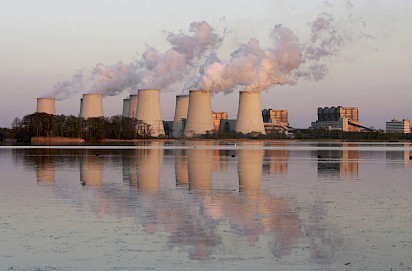How the EU's carbon border tax will work
 This week’s climate report from hundreds of top scientists makes it clear the climate crisis is underway and the human footprint is indisputable.
This week’s climate report from hundreds of top scientists makes it clear the climate crisis is underway and the human footprint is indisputable.
In three months, world leaders will meet in Scotland to beef up their climate pledges. To many policymakers and economists, the biggest lever to limit warming is government action.
One tool that’s gaining increasing purchase is what are called “carbon border taxes” — fees on imports from countries not pulling their weight to cut emissions.
Last month, the European Union unveiled the first carbon border plan of its kind. The policy is designed to start in five years and will impact pollution-heavy products such as cement, electricity, fertilizers, aluminum, iron and steel.
Since 2005, the EU Emissions Trading System (ETS) has “been showing a way forward for other places to implement their own policy at the same time that [the EU] has been able to reduce their own carbon emissions within their borders,” says Catherine Hausman, an environment and energy economist at the University of Michigan.
Canadian officials and Democratic lawmakers in the U.S. have proposed similar ideas to the ETS.
There are weaknesses within the EU’s flagship policy, however. Fees only have to be paid if a business is within Europe’s borders. Since other countries lack strict guidelines around carbon pollution, companies can set up shop elsewhere, she says.
“Leakage,” as economists like Hausman call it, can also result.
“We have a wealth of evidence on how if a single jurisdiction imposes carbon pricing within its borders and the rest of the world doesn’t, the policy isn’t as effective because emissions just happen via imports,” she explains. “So it can mean that foreign companies just export more dirty stuff to your country.”
The EU’s future carbon border tax would address these implications, she says. And since climate change is a global issue, Hausman says she and other economists hope the border adjustment will spark other countries to follow suit.
Interview Highlights
On how to fix the leakage problem, using imported cement into the EU as an example
“The basic idea is that you need to report how many tons of CO2 were released into the atmosphere when you made that cement. And then you need to pay a price equivalent to what a domestic firm within the EU’s borders would be paying.”
On whether the EU’s policy is defensible and arguably a good way to try to cut global emissions quickly
“This seems, from an economic perspective, like a no brainer because you have this massive program that has to date only applied within the European Union. And so we know from studies that there is leakage happening, meaning the policy to date just has not been as effective as it could be because the EU is importing carbon emissions, so to speak. From that perspective, border adjustments are something that economists have been talking about for years. Along the way, it can help with another really important thing, too, which is trying to get these carbon pricing schemes adopted in other places. The hope has been, with people proposing border adjustments, that if somewhere like the EU puts that price on its imports, that’s going to spur other countries to do their own domestic pricing programs.”
On the global climate debate about getting charged for pollution
“Climate change is all about global equity and who has polluted to date, but also who’s going to be hurt the most going forward. And we certainly see that, you know, the U.S. is not the country that’s going to be hurt the most. We are going to be hurt. And we already are, as we’ve seen with natural disasters of the past several years. But other countries are going to be hurt even more. And so I guess the two reasons why an economist wants a global pricing scheme, one is that it’s just a lot more effective and drives carbon emissions down much more quickly and more cost effectively. But also, there’s a fairness argument to that — it is certainly the case that we want the countries that have developed because of their carbon emissions to date to be paying a fair price going forward.”
“… You want everybody to be paying the same per pound of emissions because that’s how you look at the cost effectiveness of the program. But there have been a lot of calls for side payments to help lower-income countries develop even as they try to reduce their carbon emissions. And you can certainly see the equity argument for that.”
On what we should watch for as the EU rolls out its carbon border policy over the next five years
“The two things I’m interested in to see going forward are, No. 1, how this interacts with the very many other trade policies that are in place and that are being discussed and the other carbon pricing programs that are in place around the world. The other thing I want to look for [is] if this holds and there isn’t so much pushback that they have to roll it back. I want to look for whether this serves as a template for what other countries can do with similar border adjustments.”
You can return to the main Market News page, or press the Back button on your browser.

